Physical Address
304 North Cardinal St.
Dorchester Center, MA 02124
Physical Address
304 North Cardinal St.
Dorchester Center, MA 02124
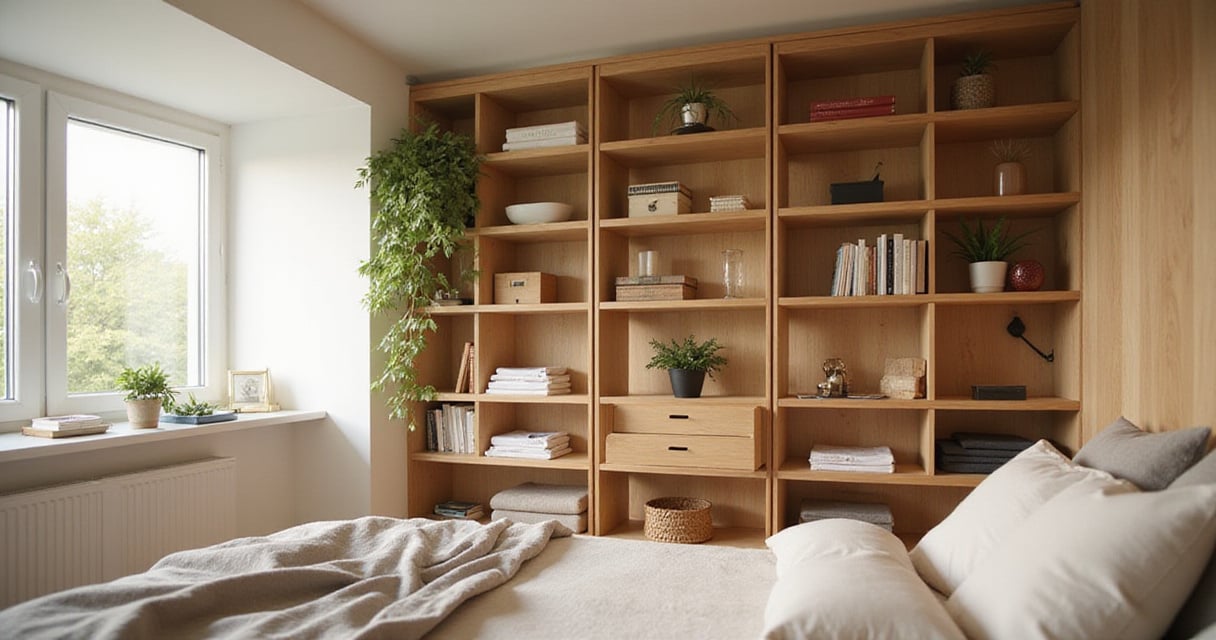
Transform your tiny space with these 19 genius small bedroom makeover ideas that maximize space and style. Learn expert tips on storage, lighting, furniture, and more to create a spacious, stylish sanctuary.
Is your small bedroom feeling more like a cramped closet than a serene sanctuary? You’re not alone! Many of us grapple with the challenge of making the most of limited square footage. But here’s the thing – small bedrooms are brimming with untapped potential.
With a dash of creativity and some smart design choices, your tiny sleeping space can transform into a stylish, spacious, and utterly inviting haven. I’ve spent years integrating tech and design in homes of all sizes, and I’ve discovered that small spaces often inspire the most innovative solutions.
Ready to unlock the secrets to a small bedroom makeover that will maximize every inch and amplify your style? Let’s dive into these 19 brilliant ideas that will revolutionize your perception of small space living!
Decluttering is the fundamental first step in any small bedroom makeover, and for good reason. Imagine trying to paint a masterpiece on a cluttered canvas – it’s just not going to work. Small spaces have a knack for magnifying clutter, making them feel overwhelmingly cramped. Before you even begin dreaming about stylish décor and space-saving solutions, you need to address the excess items taking up precious real estate.
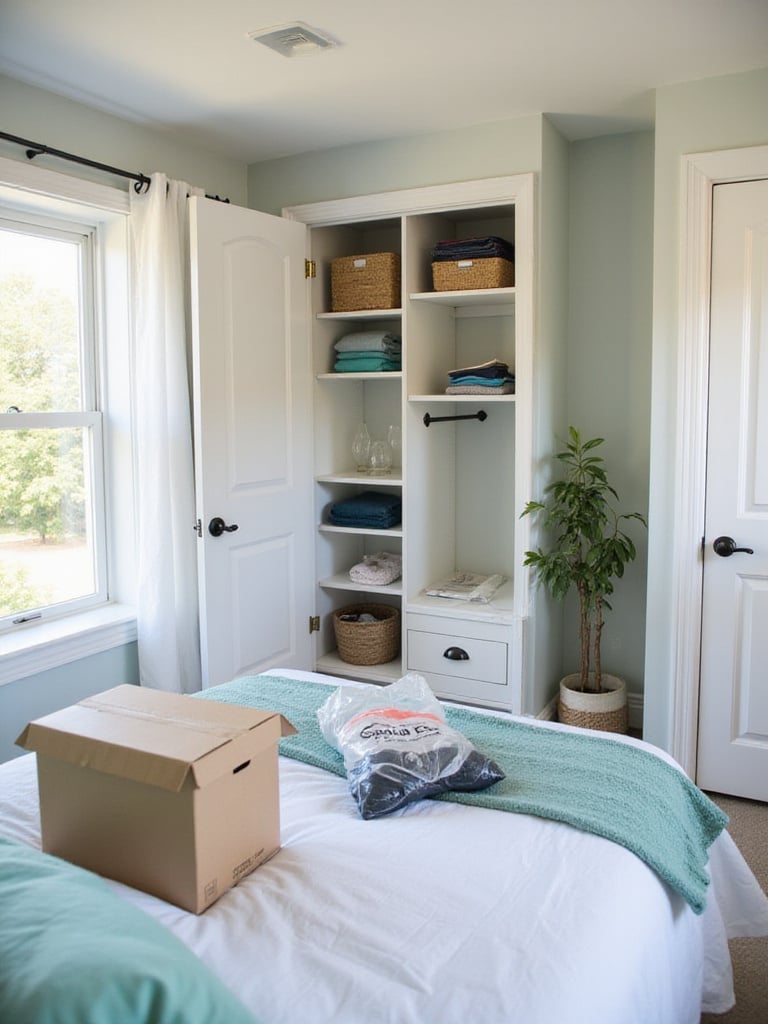
The common clutter culprits are often hiding in plain sight: clothes that no longer fit, shoes you rarely wear, books you’ve already read, and those sentimental items stored without a real purpose. These areas become prime targets for accumulating stuff, often without us even realizing it. I’ve seen countless small bedroom makeovers stall before they even begin because people skip this crucial step.
Here’s where it gets interesting – with a newly decluttered space, the possibilities for transformation are already expanding. Now, let’s brighten things up, literally, in our next step.
Light colors are masters of reflection. They bounce light around the room, creating a brighter and more open atmosphere. Dark colors, on the other hand, act like sponges, absorbing light and making a space feel smaller and enclosed. This increased reflectivity of light colors is what tricks the eye, blurring the room’s boundaries and making it feel more expansive than it actually is. I’ve installed smart lighting systems in countless small bedrooms, and I’ve always noticed how much larger they feel with a lighter color palette.
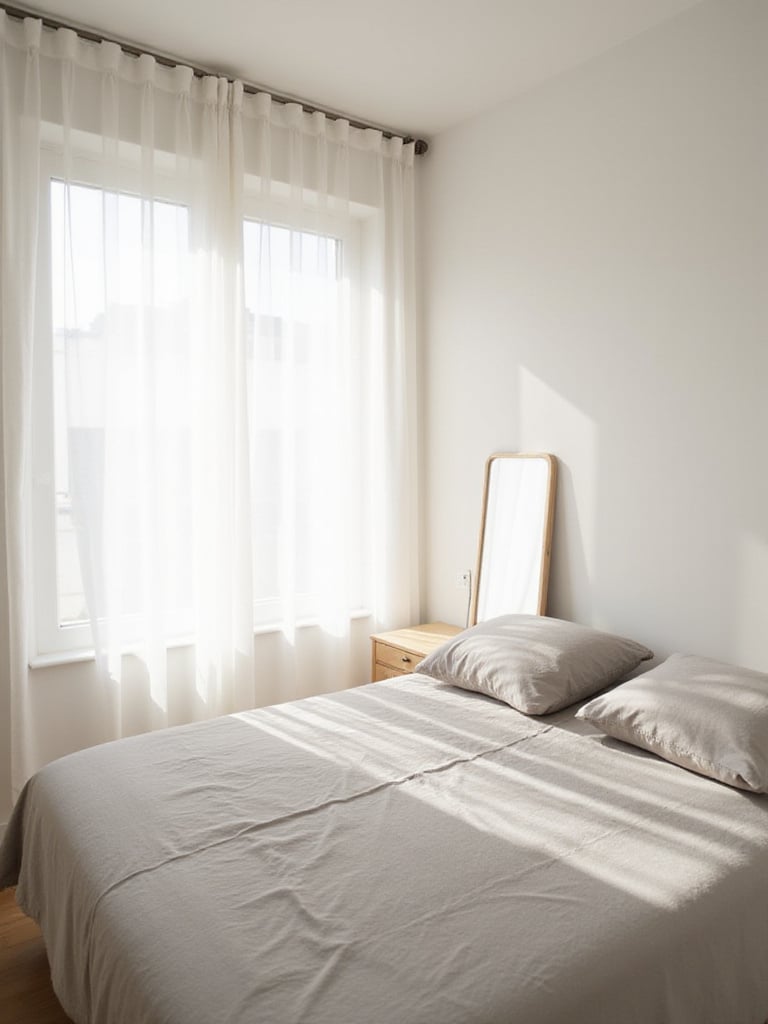
You have a delightful range of options to choose from. Whites are the undisputed champions of light reflection – pure white, off-white, cream, and ivory are timeless classics. Pastels like light blues, greens, pinks, and lavenders introduce subtle color while maintaining that airy feel. Neutrals such as light grays, beiges, and the ever-versatile “greige” (gray-beige) offer sophisticated backdrops. For rooms lacking natural light, warm whites with a hint of yellow or peach can infuse cozy warmth without feeling cramped.
“The right Light Color Palette can make a small bedroom feel twice its actual size while creating a perfect backdrop for smart home tech integration.” – James Hartford
The game-changer happened as I worked with a client whose small bedroom felt like a cave. We painted the walls a soft pearl white, and suddenly the room breathed with newfound space. Now that we’ve bathed our small bedroom in light, let’s explore another powerful tool for expanding its perceived dimensions: mirrors.
Mirrors work their magic by reflecting light and creating a sense of depth that deceives the eye. They essentially “borrow” space from other parts of the room, making it feel larger and brighter. The reflection of existing elements, like windows or furniture, extends the perceived boundaries, effectively breaking down that confined feeling often associated with small spaces. It’s like adding a secret doorway to another dimension, visually at least.
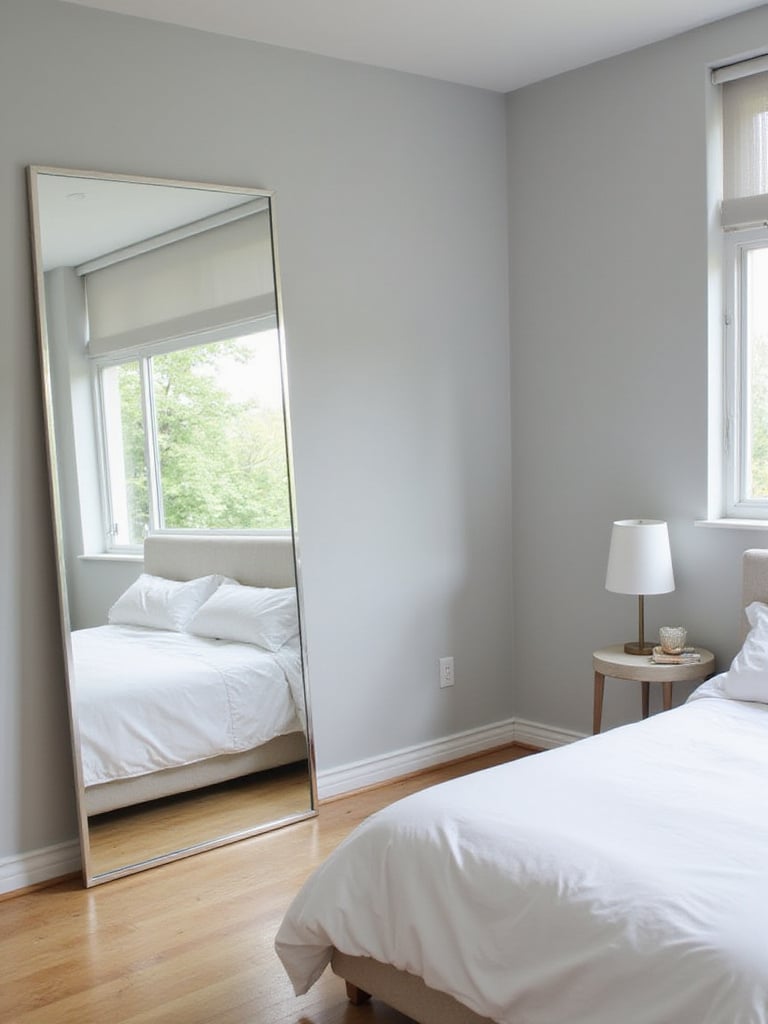
Strategic placement is key to unlocking the full potential of mirrors in your small bedroom makeover. Consider positioning a mirror opposite a window to reflect the outdoor view and draw natural light deeper into the room. Placing a mirror behind a light source, like a lamp, amplifies the light, making the room feel even brighter and more inviting. For a bolder move, a mirrored wall can dramatically expand the perceived size of the room, but carefully consider the reflections to avoid a disorienting effect.
The tricky part is making sure your mirrors don’t reflect clutter or create awkward angles. I once installed a smart mirror system that doubled as ambient lighting in a 10×10 bedroom – the transformation was stunning. With mirrors strategically placed to expand our visual horizons, let’s now turn our attention upwards and explore the vertical dimension for smart storage solutions.
In a small bedroom, floor space is gold. Vertical storage is your secret weapon because it utilizes often-overlooked wall space. It’s like discovering hidden treasure – you’re effectively expanding the room’s storage capacity without sacrificing precious square footage. Vertical solutions allow you to keep items organized and elevated, freeing up the floor and creating a more spacious and less cluttered feel underfoot.
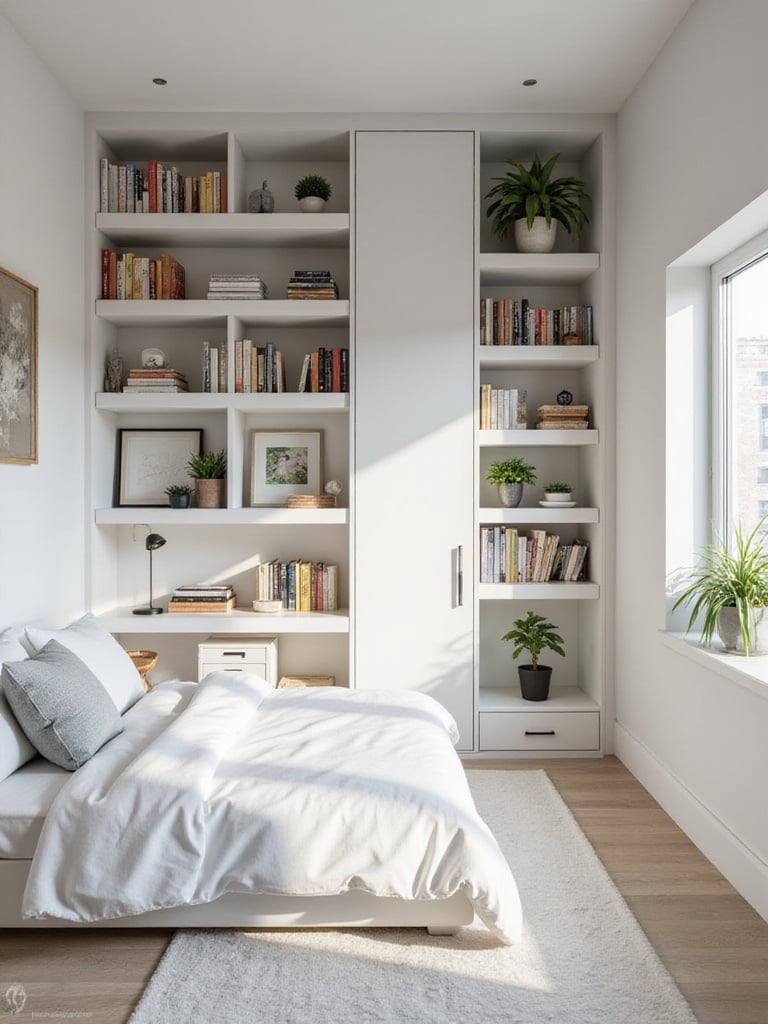
The options for vertical storage are wonderfully diverse! Consider tall bookshelves that reach as close to the ceiling as possible, drawing the eye upwards and maximizing storage. Floating shelves offer a modern, minimalist look and can be placed strategically around the room. Wall-mounted cabinets are ideal for discreetly storing clothes or personal items. Don’t forget the space above the bed, perfect for a shelf or decorative storage boxes. I’ve even integrated smart shelving with built-in USB charging stations and hidden compartments in small bedroom makeovers.
The breakthrough came when I helped a client with a tiny 8×10 bedroom install a custom vertical storage system with integrated smart lighting. Not only did it triple their storage space, but it made the room feel significantly larger. Having conquered vertical space, let’s now explore the magic of furniture that works double-duty, offering both style and space-saving functionality.
Multi-functional furniture is a game-changer for small bedroom makeovers. Its primary benefit is maximizing space by ingeniously combining the functionality of two or more pieces into one. This instantly reduces clutter and fosters a more open and airy ambiance. Beyond space-saving, it adds practicality by addressing multiple needs with a single item, streamlining your living space. It’s smart design at its finest, and as someone who integrates technology with furniture, I’ve seen how transformative these pieces can be.

There are many brilliant options available for your small bedroom makeover. A bed with built-in storage drawers underneath or a lift-up mechanism is a classic, revealing ample storage for clothes, bedding, or other items. A sofa bed ingeniously transforms from comfortable seating to a guest bed. A storage ottoman provides seating, storage, and can even double as a coffee table. A desk that folds away when not in use is perfect for maximizing floor space when work is done. I’ve even designed custom pieces that integrate charging stations and hidden tech compartments.
“The best multi-functional furniture doesn’t just save space—it enhances your lifestyle by anticipating and accommodating your daily needs.” – James Hartford
What unfolded next was fascinating—after integrating a wall bed with built-in desk and shelving for a client’s small bedroom makeover, they gained not just a bedroom but also a functional home office without sacrificing an inch of floor space. From furniture that does double duty, let’s now focus on a specific furniture type and explore how “floating” it can create even more space.
Floating nightstands are incredibly clever space-savers for a small bedroom makeover. Their key benefit lies in eliminating the need for legs, thus freeing up valuable floor space. This seemingly small detail makes a surprisingly big difference in creating an illusion of a larger, more open room. The visible floor beneath them minimizes visual clutter and also makes cleaning easier. Beyond functionality, they offer a distinctly modern and minimalist aesthetic, adding a touch of contemporary style.

Floating nightstands are surprisingly versatile in style. You can find simple shelves for a minimalist approach, nightstands with drawers for added storage, or even small cabinets that are wall-mounted. Materials range from classic wood and metal to sleek acrylic and glass. When choosing, consider the overall style of your bedroom to ensure it complements the existing décor. I’ve designed custom floating nightstands with integrated wireless charging pads and hidden LED lighting that add both functionality and ambiance.
Here’s the catch – installation requires finding wall studs for proper support, but the payoff in floor space and visual openness is worth the effort. Now that we’ve considered floating nightstands, let’s move upwards to the bed itself and explore how simple bedding choices can contribute to a spacious feel.
Simple bedding is a powerful tool for minimizing visual clutter in a small bedroom makeover, which is key to making a small room appear larger and more open. Overly patterned, textured, or brightly colored bedding can overwhelm a small space and make it feel cramped and busy. Streamlined bedding, on the other hand, allows the eye to move freely across the room, creating a sense of calm and spaciousness. It’s like visual decluttering for your bed.

The material matters as much as the style. Opt for lightweight, breathable fabrics like cotton, linen, or bamboo. These materials drape beautifully and create a smooth, uncluttered appearance. Avoid heavy, bulky fabrics like velvet or faux fur, which can add visual weight to the bed and make the room feel smaller. Even with a Neutral Color Palette, you can inject visual interest and personality through subtle textures like linen, cotton percale, or a lightly quilted duvet. I’ve found that integrating smart bedding (temperature-regulating covers or sheets with antimicrobial properties) adds function without visual weight.
Do you see how huge that is? The bed typically occupies the most visual space in a bedroom, so streamlining this area creates an immediate sense of spaciousness. With streamlined bedding in place, let’s now layer in another crucial element for spaciousness and ambiance: light.
Layered lighting is essential because it adds depth and dimension to a small space, making it feel larger and much more inviting. A single overhead light can create harsh shadows and a flat, claustrophobic feeling. By layering different types of light – ambient, task, and accent – you gain control over the mood, highlight specific areas, and create a more visually interesting and spacious environment. As a smart home integration expert, I’ve seen how transformative thoughtful lighting can be in a small bedroom makeover.

There are three key players in layered lighting for your small bedroom makeover: Ambient lighting provides overall illumination, serving as your base layer. Think dimmable overhead fixtures, recessed lighting, or a large floor lamp. Task lighting provides focused light for specific activities, like reading or getting dressed. Bedside lamps, desk lamps, or adjustable wall sconces are perfect examples. Accent lighting is used to highlight specific features, adding visual interest and depth through picture lights, small spotlights, or string lights. The integration of smart lighting systems allows you to program different scenes for different times of day or activities.
The missing piece in many small bedroom makeovers is proper lighting control. I recently installed a smart lighting system in a tiny guest bedroom that transformed the space from feeling like a closet to feeling like a boutique hotel room. Having illuminated our space beautifully, let’s bring in the freshness of nature to further enhance the feeling of airiness.
Plants are more than just décor; they’re a breath of fresh air, literally and figuratively, for small bedroom makeovers. They purify the air by absorbing toxins and releasing oxygen, potentially improving sleep quality and overall well-being. Their presence creates a calming and relaxing atmosphere, reducing stress and anxiety. Visually, they introduce a touch of nature, making the space feel more open, airy, and inviting – a welcome effect in a potentially cramped room.
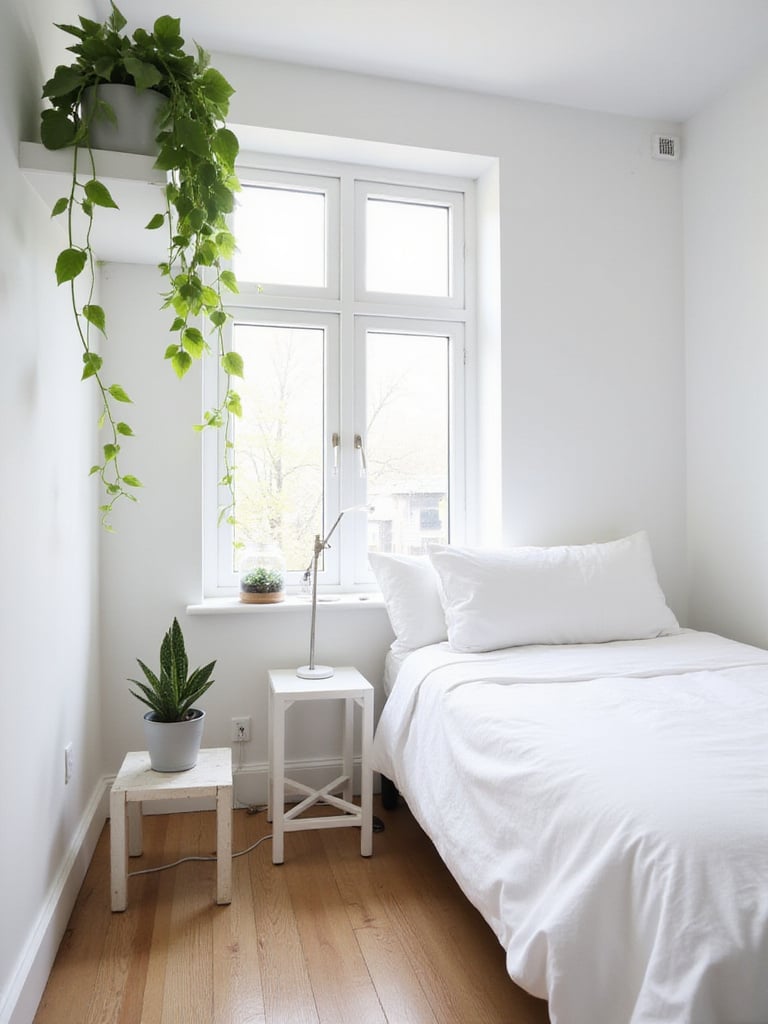
For small bedrooms, choose compact, low-light tolerant, and easy-to-care-for plants. Snake Plants (Sansevieria) are air-purifying and low-maintenance champions. ZZ Plants (Zamioculcas zamiifolia) thrive in low light with infrequent watering. Spider Plants (Chlorophytum comosum) are easy to propagate and add a cascading effect. Pothos (Epipremnum aureum) can be trained to climb or trail, and Peace Lilies (Spathiphyllum) add elegance and purify the air. I’ve even integrated smart plant monitors in some small bedroom makeovers to ensure optimal care with minimal effort.
My breakthrough came when I helped a client with a windowless small bedroom install a smart grow light system with timer controls for plants – not only did it make the room feel more natural and alive, but it significantly improved the air quality. With plants adding life and freshness, let’s now consider how rugs can help define zones and add depth to our small bedroom makeover.
In a small bedroom where space is limited, distinct zones can easily blur together. Rugs act as visual anchors, clearly defining different areas like the sleeping zone, a reading nook, or a workspace. Placing a rug under the bed anchors the sleeping zone, while a smaller rug under a desk or chair designates a separate work or reading area. The contrast between the rug and the surrounding flooring creates a visual break, making the room feel more organized and spacious.

Rug size depends on the zone in your small bedroom makeover. For the bed area, the rug should ideally extend at least 18-24 inches beyond the sides and foot of the bed, creating a soft landing and visually anchoring it. For a reading nook, a smaller rug fitting entirely under the chair and a small table is sufficient. Strategic use of rug colors and patterns can significantly enhance depth perception. Lighter colors make a space brighter and more open, while darker colors ground it. Bold patterns or geometric designs draw the eye and create movement, making the room feel less static.
The game-changer happened when I helped a client define a small workspace in their bedroom with a round rug that contrasted with their rectangular bed rug – suddenly the room felt like it had distinct purposes without adding walls or dividers. Having defined our zones, let’s now look downwards again, this time to unlock hidden storage beneath the bed.
Under-bed storage is like discovering a secret room in your bedroom! It maximizes otherwise unused space, decluttering the room and creating a more organized and visually appealing environment. It’s especially valuable in small bedroom makeovers where floor space is at a premium. Storing items under the bed frees up closet space and reduces the need for bulky dressers, contributing to a sense of spaciousness. I’ve designed custom under-bed storage solutions with wheels and dividers that make accessing items as easy as opening a drawer.

Items used less frequently are ideal candidates for under-bed storage in your small bedroom makeover. Think seasonal clothing, extra bedding (blankets, pillows, comforters), shoes, out-of-season decorations, luggage, and books. Look for durable, stackable containers with secure lids to protect items from dust and pests. Clear containers are perfect for easy content visibility. Consider your bed frame height and choose containers that fit comfortably underneath. Some containers have wheels for easier access, and fabric bins are a good option for softer items like clothing.
Let me paint you a picture: I once worked with a client who gained the equivalent of an entire closet’s worth of storage just by utilizing the space under their bed with custom containers. Having maximized under-bed space, let’s now turn our attention to the furniture itself and consider slimming it down for a less crowded feel in your small bedroom makeover.
Oversized furniture in a small bedroom is like wearing shoes that are two sizes too big – uncomfortable and overwhelming. Appropriately scaled furniture allows for better flow and maximizes usable space in your small bedroom makeover. It creates a sense of airiness and makes the room feel larger than it actually is. When integrating technology into small bedrooms, I always recommend sleek, minimal pieces that don’t dominate the visual space but still offer full functionality.

Bulky bed frames, oversized nightstands, and large dressers are common culprits that overwhelm small bedrooms. Opt for a platform bed or a frame with minimal detailing instead of a traditional bed frame with a headboard and footboard. Replace bulky nightstands with floating shelves or narrow bedside tables. Choose a tall, narrow dresser over a wide, low one to maximize vertical storage while minimizing floor space. I’ve found that furniture with built-in tech features (like integrated charging stations) can eliminate the need for additional pieces like phone docks or desk lamps.
The surprising part is how much larger a room can feel simply by swapping out a few oversized pieces for properly scaled alternatives. I’ve seen small bedroom makeovers where replacing just the bed frame made the room feel 30% larger. With streamlined furniture in place, let’s consider the bed’s centerpiece: the headboard, and how to choose one that enhances style without overwhelming the room.
A headboard can be a powerful focal point in your small bedroom makeover, drawing the eye upwards and creating a sense of height. Choosing the right style, material, and color is key to impacting the perceived size and style. A tall headboard emphasizes vertical space, while a light-colored or upholstered headboard adds softness and visual interest without adding clutter. I’ve designed custom headboards with integrated smart features like reading lights, speakers, and charging ports that add functionality without visual bulk.

Headboards with a low profile or those that attach directly to the wall are excellent choices for small bedrooms. Upholstered headboards with simple designs and light-colored fabrics add comfort and style without taking up too much space. Open-frame headboards, like metal or wicker, allow light to pass through and maintain openness. When selecting a headboard for your small bedroom makeover, consider your bedroom’s color palette, furniture style, and overall aesthetic. Pay attention to the headboard’s scale in relation to the bed and room size – proportion is key.
Let that sink in for a moment – the right headboard can serve as both a functional piece and the artistic focal point of your small bedroom makeover. With a stylish headboard in place, let’s now turn our attention back to windows and how to maximize natural light by choosing the right window treatments.
Natural light is transformative in a small bedroom makeover. It makes the room feel larger, brighter, and more airy, which is crucial to avoid a cramped feeling. Natural light also enhances colors, making them appear more vibrant. Beyond aesthetics, natural light has psychological benefits, improving mood and overall well-being, particularly important in a space for rest and relaxation. As someone who integrates smart home technology, I’ve seen how proper light management can transform a space.

Sheer curtains offer several advantages for your small bedroom makeover. They allow ample natural light to filter through, creating a bright and welcoming atmosphere. They provide a degree of privacy without completely blocking light or view. Their lightweight nature makes them appear less bulky and visually heavy than thick drapes, contributing to spaciousness. To address the limited privacy, layer sheer curtains with blackout blinds or shades for daytime light and nighttime privacy and darkness. I often recommend smart blinds that can be programmed to open and close at specific times, giving you both privacy and natural light when you need them.
Things took an interesting turn when I helped a client replace their heavy drapes with layered sheers and automated blinds – the room instantly felt twice as large and much more inviting. With natural light maximized, let’s consider the art of decoration, focusing on intentionality and minimizing clutter in your small bedroom makeover.
In a small bedroom makeover, every item competes for visual space. Random, meaningless clutter quickly overwhelms the room, making it feel cramped and chaotic. Intentional decorating, focusing on meaningful items, ensures each piece positively contributes to the aesthetic and emotional atmosphere, rather than just taking up space. This approach fosters a sense of calm and curated comfort, crucial for a restful environment. I’ve seen how thoughtfully chosen tech pieces can serve as both functional tools and meaningful design elements.

Meaningful items evoke positive emotions, memories, or represent your personality and interests. Consider sentimental items like family heirlooms, travel souvenirs, handmade gifts, or pieces reflecting your hobbies. Ask yourself: Does this item bring me joy? Does it tell a story? Does it contribute to the feeling I want in my bedroom? Even with meaningful objects, balance and editing are key. Too many items, regardless of significance, can negate positive impact and lead to claustrophobia. Prioritize cherished pieces and rotate them seasonally to keep the space fresh and uncluttered.
My discovery began when I worked with a client who replaced dozens of knickknacks with just three meaningful art pieces – the room instantly felt more spacious, and each piece got the attention it deserved. Having decorated intentionally, let’s now think about creating a dedicated nook for relaxation within our small bedroom makeover.
A cozy nook, even in a small bedroom makeover, provides a mental escape within limited space. It delineates zones, preventing the bed from feeling like the only space to exist. It fosters calm and provides a comfortable spot for de-stressing, reading, or unwinding, contributing to overall well-being and a more balanced living experience in a small space. I’ve designed tech-integrated nooks with ambient lighting, hidden speakers, and charging stations that create a truly immersive relaxation experience.

Key elements of a successful cozy nook include comfortable seating (armchair, floor cushions, small loveseat), soft lighting (reading lamp, string lights, candles), a small surface for drinks or books (side table, floating shelf), and cozy textiles (throw pillows, blankets, rugs). Personalization is crucial – add items you enjoy like plants, artwork, or cherished objects. Visually distinguish the nook from the sleeping area to create a sense of separation. I often recommend smart lighting that can be adjusted via voice command or app to create the perfect ambiance without getting up.
Picture it this way – a small bedroom isn’t just for sleeping; it can be a multi-functional haven with distinct zones for different activities. Having carved out a cozy nook, let’s shift our focus to existing furniture and explore how to repurpose and reimagine it for our small bedroom makeover.
Repurposing furniture is a smart move for a small bedroom makeover. It saves money, reduces waste, and allows you to create unique, personalized pieces perfectly fitting your needs. It avoids the expense of new furniture and optimizes existing pieces for maximum functionality in limited space. As someone who integrates technology with furniture, I’ve found that repurposing often provides opportunities to add smart features that wouldn’t be possible with off-the-shelf pieces.

When deciding which furniture pieces to repurpose for your small bedroom makeover, consider each piece’s size, functionality, and aesthetic potential. Prioritize items that can serve multiple purposes or be adapted to better suit your needs. Assess structural integrity – if damaged beyond repair, it might not be suitable. I’ve transformed old dressers into media centers with integrated charging stations, converted headboards into wall-mounted desks, and repurposed old nightstands into floating shelving units with hidden storage.
It works something like this: instead of seeing furniture for what it is, see it for what it could be. I once helped a client transform an old entertainment center into a compact workspace with hidden storage, completely changing how they used their small bedroom. With repurposed furniture adding unique character, let’s now consider DIY projects as a budget-friendly way to personalize and optimize our small bedroom makeover.
DIY projects provide tailored solutions to fit your small bedroom’s specific dimensions and needs. Instead of standard, often bulky, furniture, you can create custom pieces like floating shelves, narrow bedside tables, or under-bed storage perfectly utilizing available space. DIY also allows upcycling existing items, transforming them into functional and stylish storage or décor without adding clutter. As a tech integration specialist, I’ve found that DIY projects offer unique opportunities to incorporate smart features exactly where you need them.

For your small bedroom makeover, embrace affordable materials like reclaimed wood, pallets, inexpensive lumber, fabric remnants, and repurposed jars or containers. Check thrift stores, garage sales, and online marketplaces for discounted furniture or materials to transform with paint, stain, or new hardware. Use contact paper or peel-and-stick wallpaper to update surfaces affordably. Don’t underestimate the power of paint – a fresh coat dramatically changes a room’s look. Avoid overcrowding with too many DIY projects and plan carefully, prioritizing functionality and aesthetics.
Here’s what happened when I guided a client through a DIY small bedroom makeover: we created a custom headboard with integrated lighting and charging ports for less than half the cost of a store-bought smart headboard, and it perfectly fit their space and style. Finally, as we bring all these ideas together, let’s find our focus and choose one element to anchor our small bedroom design.
In a small bedroom makeover, a focal point prevents a cluttered and overwhelming feeling. It provides a visual anchor, giving the eye a place to rest and creating order and intention. By drawing the eye upwards, it can also make the room feel taller and more spacious. A focal point is like a visual compass, guiding the eye and creating harmony. I’ve designed tech-integrated focal points that serve both as aesthetic anchors and functional elements.

Effective focal points for your small bedroom makeover include a statement headboard (upholstered, carved, or brightly colored), a gallery wall above the bed, a large piece of art, a striking light fixture (chandelier or pendant lamp), a feature wall with wallpaper or bold paint, or even a well-styled bookshelf. Consider the room’s architecture and layout. Is there a natural focal point like a window with a view or unique architectural detail? Scale is crucial – ensure the focal point is appropriately sized for the room. Too small, it gets lost; too large, it overwhelms.
The implications are staggering – a well-chosen focal point can completely transform how you perceive the size and proportion of your small bedroom. My experience has shown that rooms with a clear focal point feel more intentional, balanced, and surprisingly, more spacious than those without this key design element.
Transforming a small bedroom from cramped to captivating is absolutely achievable! By embracing these 19 brilliant ideas, you can maximize every inch of space and infuse your personal style into your sanctuary. From decluttering and lightening up with color, to utilizing vertical storage and multi-functional furniture, each tip works in harmony to create a bedroom that feels both spacious and stylish.
Remember, intentional decorating, personalized DIY touches, and a well-chosen focal point are the keys to unlocking your small bedroom’s full potential. As someone who’s integrated smart technology into countless small bedroom makeovers, I’ve seen firsthand how these strategies can transform even the tiniest spaces into functional, beautiful retreats.
Don’t let limited square footage limit your dreams – implement these ideas, get creative, and craft a bedroom that truly reflects your personality while providing a haven of comfort and style. Your dream small bedroom makeover is waiting to be revealed!